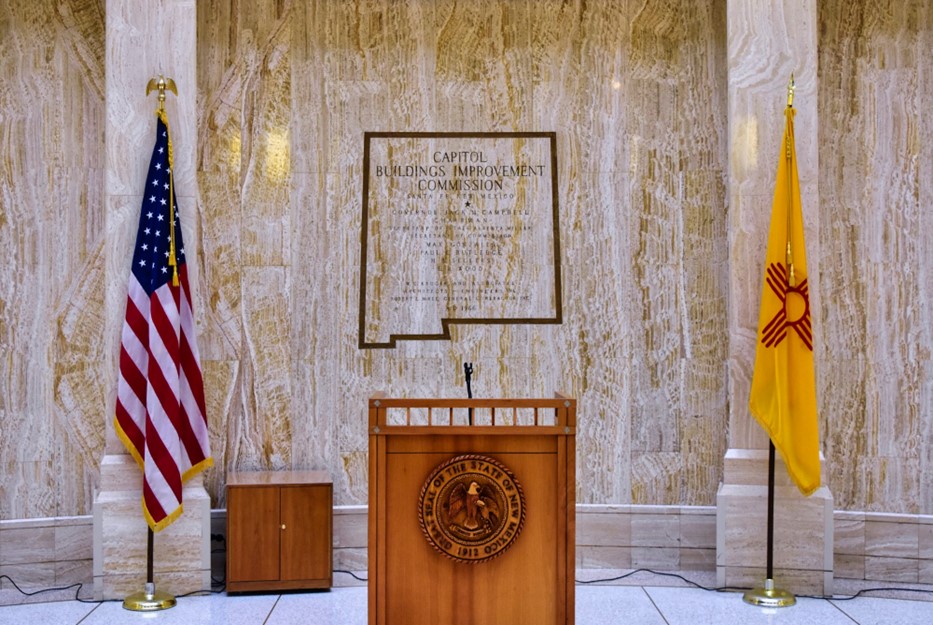
Tomorrow, at noon, Jan. 21, the first session of the 57th Legislature will convene a 60-day general session that ends on March 22, 2025. In a general session, there is no restriction on the subjects that can be considered. We expect that over 1,000 bills will be introduced. The Chamber’s legislative team will sift through the mass of legislation, focusing attention on those measures that will advance or hamper New Mexico’s economic competitiveness.

New Mexico is not an island fortress immune from global and national economic forces. Our state has many unique qualities that make it an attractive place to live or visit: diverse culture, natural beauty and lots of space. However, we must deal with several undesirable factors that hurt our economic competitiveness compared to surrounding states and other regions of the country.
What holds us back? Why do New Mexicans have lower incomes? Here are some key reasons:
- Our public school system is the worst in the nation despite substantially increased funding.
- Our communities are not safe, and we’ve earned a reputation as a crime-ridden state.
- Drug abuse, especially fentanyl, boosts crime and threatens the lives of our children.
- Too many of our best and brightest young people leave our state, finding better jobs elsewhere.
- Our healthcare system faces critical shortages of physicians, nurses, mental health professionals and technicians.
These are some of the key areas that need to be tackled if our economic competitiveness is to improve and New Mexicans are to have higher incomes, safer communities and a robust healthcare system much less dependent on what amounts to government subsidies via Medicaid that, at best, barely cover the cost of care.

On Friday, the Chamber will roll out its legislative agenda developed in cooperation with our many business partners in both the public and private sectors and approved by our Board of Directors. At that time, we can share with you all the detailed actions we believe are necessary to move the ball down the field. First and foremost, we need for decision makers to come together around the goal of vastly improving New Mexico’s economic competitiveness. Then we need consensus on specific steps to be taken:
- Make New Mexico a Safer Place: Drug addiction and other behavioral health disorders are a key driver of the state’s crime problem – increased investment in addiction services and treatment are needed. At the same time, laws need to be strengthened to make it harder to be a criminal in our state. Stiffer penalties for serious and violent crimes, ending the revolving door to keep bad guys off the streets, increasing the ranks of law enforcement and equipping them with the most modern crime-fighting technology are all key steps.
- Reduce the Tax Burden on businesses and families. Despite hundreds of millions of dollars of “new money,” neither the executive or legislative budgets contain any form of tax relief or reform. The high gross-receipts tax and tax “pyramiding” are major burdens on New Mexico’s small businesses. Ninety percent of New Mexico businesses have 20 or fewer employees.
- Ensure High-Performing Schools Are Run by Great Leaders: There is a direct correlation between school performance and great leaders who, in turn, attract great teachers, who, in turn, produce excellent student outcomes. Leadership development, expansion of high-quality charter schools and early literacy development are all key ingredients to making this goal a reality. Businesses won’t come to New Mexico, nor will they expand, unless there is a qualified workforce.
- Make New Mexico an Attractive Place to Practice Medicine: It’s not really healthcare if it’s hard to find a doctor and medical appointments take months to schedule. Lowering GRT taxes on medical providers and patients, raising Medicaid reimbursement rates and overhauling the medical malpractice system are among necessary steps.

Follow the Money
Where taxpayers’ money is spent clearly says what the priorities are. So, what’s the starting point for the state budget? Both the executive and legislative total budgets are very close: $10.9 billion versus $10.8 billion – around a 6% increase, which budget writers believe is a sustainable level of spending on a go-forward basis. Under Gov. Michelle Lujan Grisham, the budget has increased 45% since she took office in 2019, as summarized in this table from the LFC:
Public Education and Medicaid are the areas with the largest percentage growth. State Medicaid dollars are used to leverage significant federal government contributions to the program. According to Senate Finance Committee Chair George Muñoz (D-Cibola, McKinley and San Juan), the difference in the two budgets is about 1%, with the governor including $200 million for the strategic water plan and different funding levels for reserves, behavioral health and roads. Nevertheless, Muñoz observed this is the closest the two budgets have ever been at time of introduction. However, we noted that neither budget proposal includes any money for tax relief or restructuring, which we will work hard to have addressed during the session.

Here are some top budget highlights from the legislative proposal (budget considerations originate in the House):
- $3 billion in nonrecurring appropriations including $350 million for transportation projects, $855 million for special projects and $1.7 billion in transfers to endowments and other funds.
- $263 million increase to public schools.
- An almost $3 billion increase in the Health Care Authority budget, to $15 billion from $12.2 billion largely due to imposition of a hospital surcharge. Seventy-nine million dollars will be added for the Medicaid program. Since 2019, the Medicaid budget has doubled.
- 4% salary increase for state employees, including educators and administrators.
- $706 thousand increase for the Economic Development Department.
- $1.304 billion for roads with an additional $350 million from the general fund.
- $350 million for the Government Results and Opportunity (GRO) Fund to support pilot programs and innovate reforms, closely monitored to determine results before funding on a permanent basis.
- $222 million for water projects.
- $1.7 billion of capital outlay requests despite the fact that outstanding capital balances (money not spent) sit at $5.8 billion spread over 5,000 projects. The capital outlay system is still in need of significant reform.

Signing Off from Albuquerque
Tomorrow, the Roundhouse will be crackling with energy as legislators settle into their offices, old friends are greeted and new friends are made. Especially for new legislators, families will proudly watch them be sworn into office. The governor will make her way down to the House chamber where a joint session of the Senate and House will receive her State of the State message. Then after the pageantry, the long grind toward the final gavel of the session begins. We’ll be there every step of the way to bring you all the news and views. Until then, have a wonderful evening.



